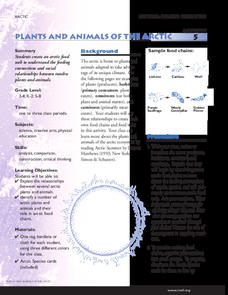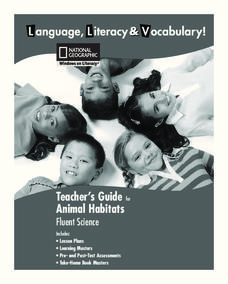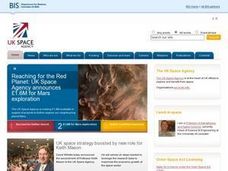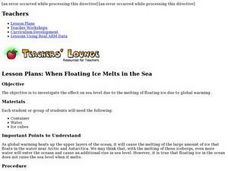Consortium for Ocean Science Exploration and Engagement (COSEE)
Arctic Smorgasbord
Though the walrus spends roughly one third of its time on land, it eats organisms that live on the bottom of the ocean. The first in a series of five, the lesson uses a variety of plant and animal cards to have scholars build an arctic...
National Wildlife Federation
Massive Migrations: Grades 5-8
Many Arctic species only spent a fraction of their lives in the Arctic region. Scholars research migrating Arctic species to learn more about their habits. They focus on their migration habits including distances, time, and challenges...
National Wildlife Federation
Plants and Animals of the Arctic
The Arctic food web may be more limited than other environments, but it has all the same components. With an interactive activity, pupils assume the roles of the components of an Arctic food chain. They move around and link themselves to...
National Wildlife Federation
Where In the World Is the Arctic?
Exactly how far away is the Arctic? Learners use maps to orient themselves to their locations on the globe. They then make calculations to describe how their location relates to the location of the Arctic regions.
College Board
2005 AP® Environmental Science Free-Response Questions
Can the increase in meat production keep pace with the increase in population? Individuals analyze data to determine when human populations will exceed meat production at the current rates of increase. They also consider infectious...
Beyond Benign
The Big Melt: Arctic Ice Caps
Are the Arctic ice caps really melting out of existence? Junior climatologists examine the statistics of ice decline through four math-based lessons. Each activity incorporates data, climate information, and environmental impact into an...
Polar Trec
Permafrost Thaw Depth and Ground Cover
The thaw depth of tundra creates a positive feedback loop with both global warming and the carbon cycle. Scholars sort photos and develop a hypothesis for ground cover and permafrost depth. Then they review the data and measurements...
Polar Trec
Touring the Poles
Would you want to vacation in the Arctic or Antarctic regions? Scholars research both regions and produce a travel brochure trying to convince tourists to visit. The project focuses on the geography, climate, flora, fauna, and indigenous...
NOAA
Where Have All the Glaciers Gone?
What happens when ice melts? Well ... water happens. When that melting ice is a glacier, the amount of water that results produces change throughout the world. Middle school science sleuths uncover the truth about global warming, the...
National Park Service
Aspect, Treeline, and Climate
Head to the treeline and beyond to examine how this feature of the landscape affects weather and climate, which gives scientists clues about its health. Class members' observations of photographs provide the data that drives the...
Chicago Botanic Garden
Food for Thought: Climate Change and Trophic Cascades
Learners examines the arctic food web with a short video about polar bears and an article about bears and warming temperatures. They design an arctic food web and discuss the trophic cascade that could come from climate change.
Polar Trec
Arctic Smorgasbord!
Two blooms of phytoplankton, instead of just one, now occur in the Arctic due to declining sea ice, which will have widespread effects on the marine life and climate. In small groups, participants build an Arctic food web with given...
National Geographic
Animal Habitats
Explore animal habitats and reinforce speaking, listening, reading comprehension, and writing skills with a unit that focuses on the Arctic, desert, ocean, prairie, and rainforest. Enthusiastic scientists read informational text to...
World Wildlife Fund
Bar Charts & Pie Charts
Learn about life in the Arctic while practicing how to graph and interpret data with this interdisciplinary activity. Starting with a whole group data-gathering exercise, students are then given a worksheet on which they analyze and...
World Wildlife Fund
Land of the Midnight Sun
From days of 24 hour sunlight, to endless nights that last for days, the Arctic is a very unique place to live. Examine the seasonal changes that occur in the northern-most reaches of the globe and the impact they have on the plants and...
World Wildlife Fund
Arctic Food Chain
Explore the food chains that support Arctic ecosystems. A class discussion on interdependence and the different roles plants and animals play in ecosystems provides students with the knowledge to complete a worksheet asking them to...
Curated OER
Polar Bears
What do you know about polar bears? Get your youngsters writing about these majestic animals with this short writing activity. They simply use the six words provided to create a short story about the picture provided. Review the words...
Curated OER
Arctic Writing
Fifth graders analyze photographs in order to write descriptively. In this descriptive writing lesson, 5th graders use the Internet to research and view photographs of the arctic. Students use descriptive language to write sentences...
Curated OER
Cryosat Mission
Beginning with general information on satellites and seasons, concluding with polar ice and the Cryosat Mission, this worksheet gives your earth scientists an opportunity to conduct some research. Most of the assignment consists of short...
Curated OER
Habitats - Explore the World Around You.
Explore the habitats found around the world. The Desert, Rain Forest, Tundra, Prairie, Grassland, Forest, Marine and Zoo habitats are all covered in this easy to follow presentation. Each slide has a themed background picture, several...
Curated OER
When Floating Ice Melts in the Sea
With this simple inquiry exercise young scientists observe the effects of melting ice on water level. Set up an easy experiment with floating ice cubes in a dish of water then have your pupils make and record their observations of the...
Curated OER
Researching Polar Animals
Second graders read the questions about polar animals and use the Internet to perform a search for the answers to the questions. They click on the blue links to go to the particular website with the answers and then print off their sheet.
Curated OER
Climate Change
Ninth graders compare the Arctic and Antarctic. In this climate activity students work in groups, research and complete an oral report or a poster.
Curated OER
Biomes: Land of the Inuit
Students study Inuit and their ancestors. In this biomes lesson students study the relationship between the Inuit and their environment and create a class art gallery.

























